A heavily forested state bordering the Great Lakes, Michigan is home to several different species of owls. For those who aren’t year-round residents, Michigan may also serve as a breeding or wintering ground. Continue reading below to learn about the different owls that live in Michigan and how to recognize them in the wild!
1. Great Horned Owl
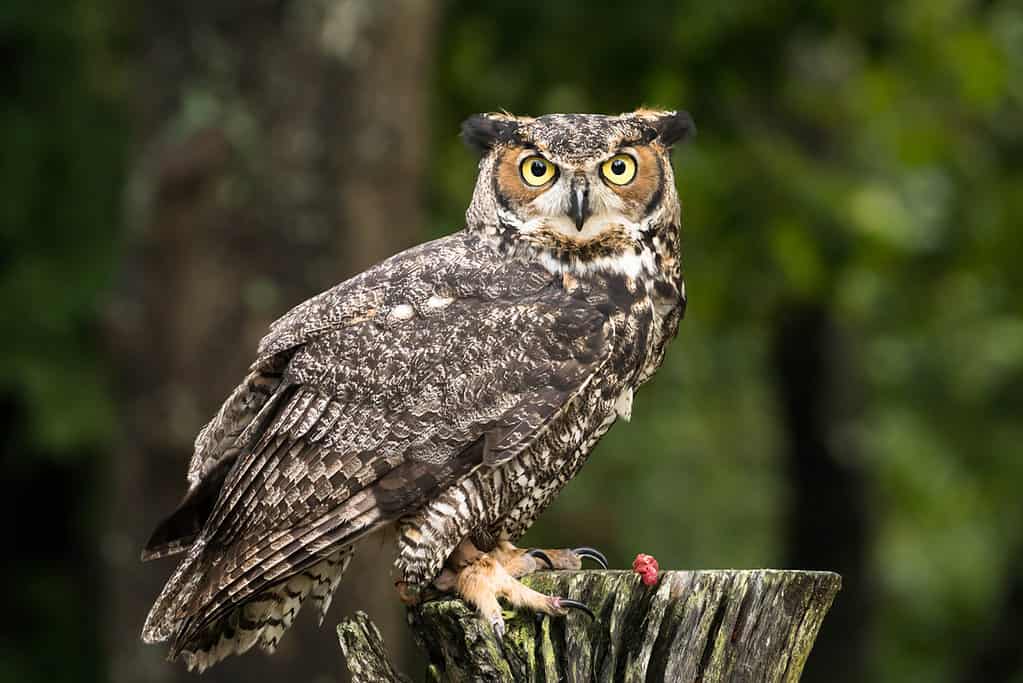
Great horned owls have the most diverse diet of all North American raptors.
©iStock.com/makasana
The great horned owl is a non-migratory species found throughout North America and South America. They can be found in all of Michigan. They live in woodlands, orchards, swamps, and forests. However, they can also be seen in suburban and urban areas.
Of all the raptors in North America, great-horned owls are considered to have the most diverse diet. They eat small rodents, rabbits and hares, skunks, scorpions, geese, small songbirds, ducks, and other raptors. When available, great horned owls are also large enough to prey on small pets left unattended outside.
When you think of owls, you likely think of nighttime predators. However, while this is common, the great horned owl is also known to occasionally hunt during the daytime. This includes during broad daylight.
2. Barn Owl
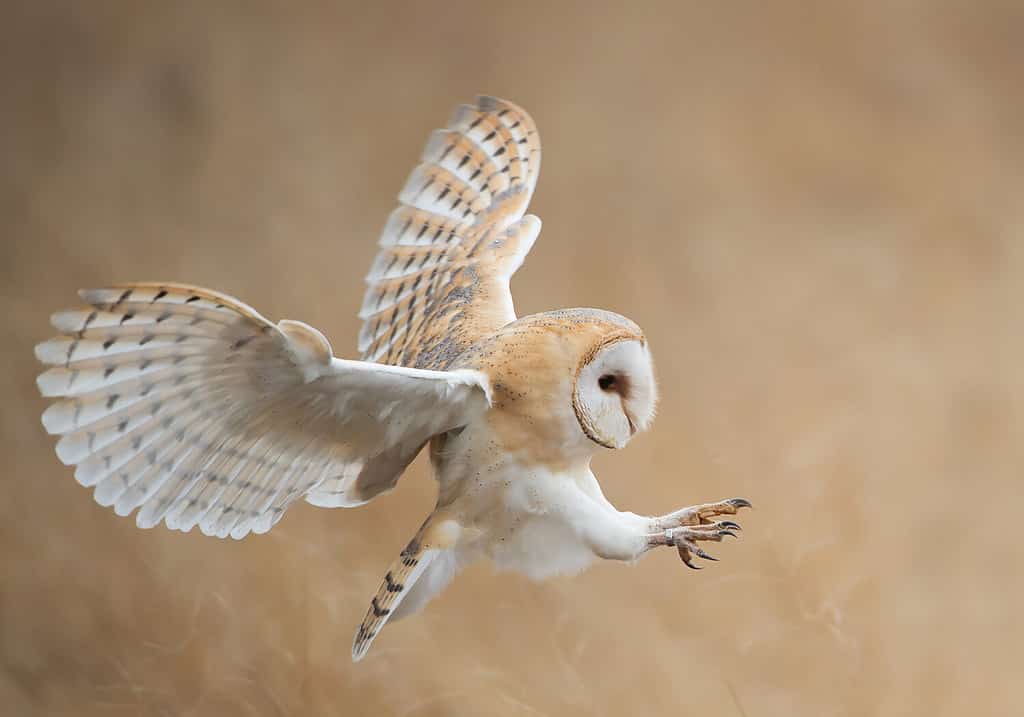
Many cultures believe that owls hold supernatural knowledge and can help foretell the future.
©MZPHOTO.CZ/Shutterstock.com
The barn owl is less common in the state of Michigan than the great horned owl. They are found throughout the southern regions of the state. However, while they do cover a small percentage of Michigan, like the great horned owl, the barn owl is a year-round species.
Barn owls prefer open spaces. This includes areas like grasslands and pastures. However, they may also decide to settle in areas near humans. This includes suburban and urban areas. When they nest, they do so in tree cavities and buildings.
Like many other species of owls, the barn owl eats mainly small rodents. They are nocturnal predators and, as a result, don’t often eat animals like squirrels that are active during the day. They may also eat other small birds. While a barn owl is nesting, they may store food near the nest. This allows them to easily feed their offspring after they hatch.
3. Long-Eared Owl
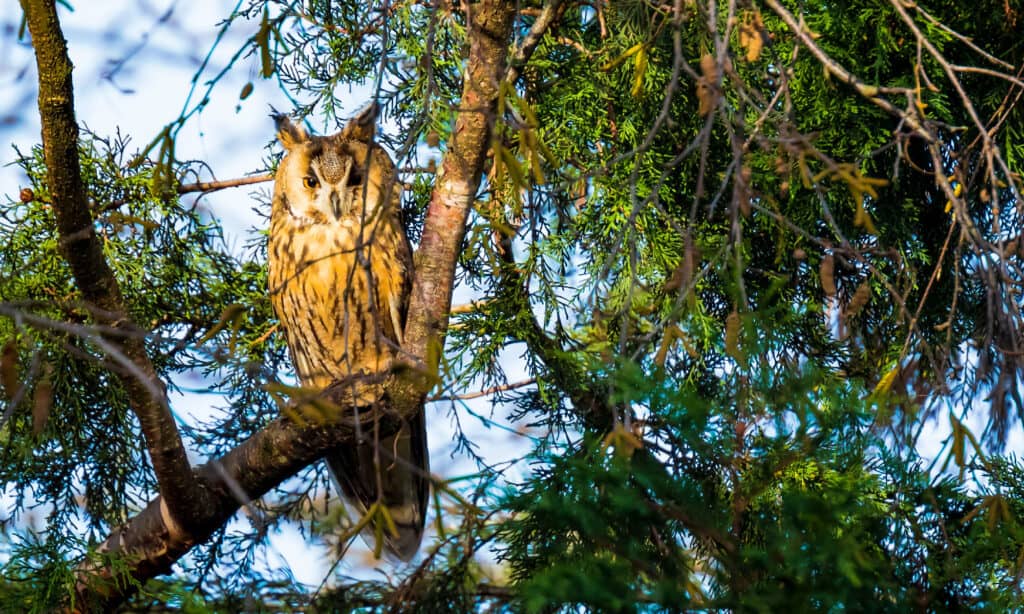
Long-eared owls are named for their tufts of feathers that resemble ears.
©SanderMeertinsPhotography/Shutterstock.com
A year-round population of long-eared owls lives throughout much of the middle of Michigan. Towards the north, individuals of this species may breed and nest; to the south are wintering grounds. Michigan is one of the few places not only in the United States but North America, where all three territories are present. When migrating, they will do so typically only at night.
Long-eared owls will roost in areas of dense vegetation. However, they will forage and hunt in open spaces where prey can easily be spotted and captured.
4. Short-Eared Owl
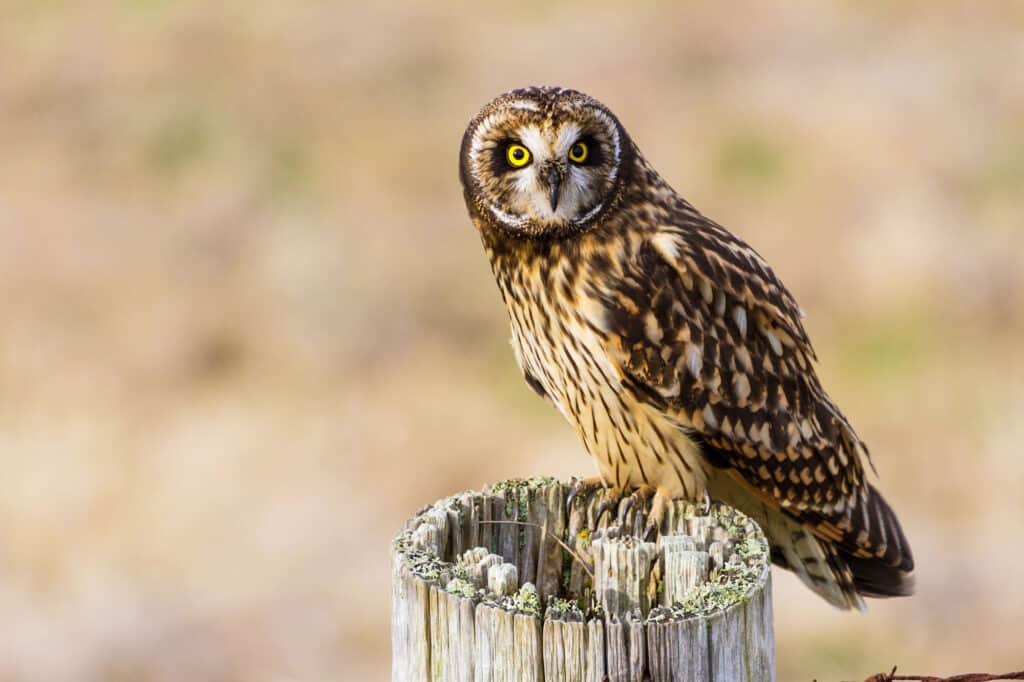
The short-eared owl is vulnerable to other raptors, such as bald eagles, northern goshawks, red-tailed hawks, and snowy owls.
©iStock.com/Devonyu
The short-eared owl is both a migratory and resident species in Michigan. The northern region is located within their breeding territory. In the central and southern regions, short-eared owls can be found throughout the year. They live in open areas with low vegetation, ranging from rock quarries to coastal grasslands.
Their diet mainly consists of small mammals. This includes those such as mice and voles. However, they are also known to hunt and eat other birds. When doing so, they will first tear the wings from their prey prior to consuming it.
5. Northern Saw-Whet Owl
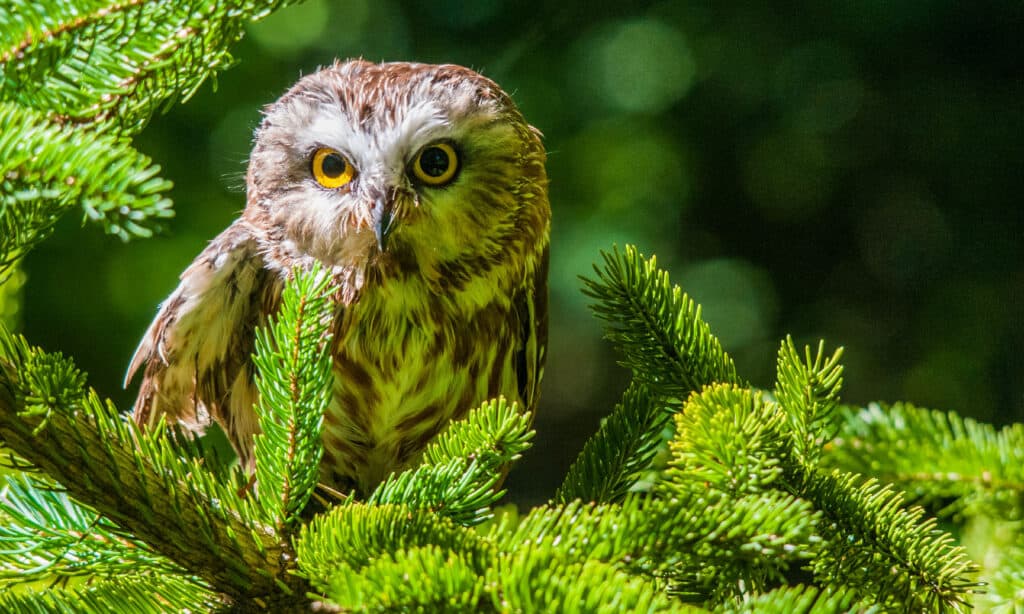
Northern saw-whet owls can be found nesting in man-made boxes.
©iStock.com/bookguy
Juvenile northern saw-whet owls have a striking appearance that can be hard to miss. They have a cinnamon-colored body with a darker brown head. What is most notable, however, is the white V-shaped tuft of feathers between their eyes. As the rest of their plumage gains more white marks, this V will become less noticeable but can still be spotted in adults.
The entirety of the state of Michigan acts as a year-round territory for the northern saw-whet owl. They prefer mature forests, usually near rivers. They may also choose to rest in man-made nesting boxes.
6. Barred Owl

Barred owls are one of the most common species.
©Jim Cumming/Shutterstock.com
The barred owl is one of the most common species of owl in eastern North America. They live year-round throughout the entirety of Michigan. You can often expect to find these owls in mixed forests near fresh water. This is because these types of areas are able to support a diversity of prey species for them to hunt.
They eat a variety of small mammals, birds, and amphibians. For small prey, they will consume it whole, later regurgitating those pieces they cannot easily digest, such as bones. Larger prey will be consumed in pieces, beginning with the head and then the rest of the body.
You may be familiar with the barred owl’s distinctive call. Many say that it sounds like a spooky question asking, “Who cooks for you? Who cooks for you all?” You may find some individuals that sport heavier white markings than others, who have an overall more buffed appearance.
7. Eastern Screech Owl
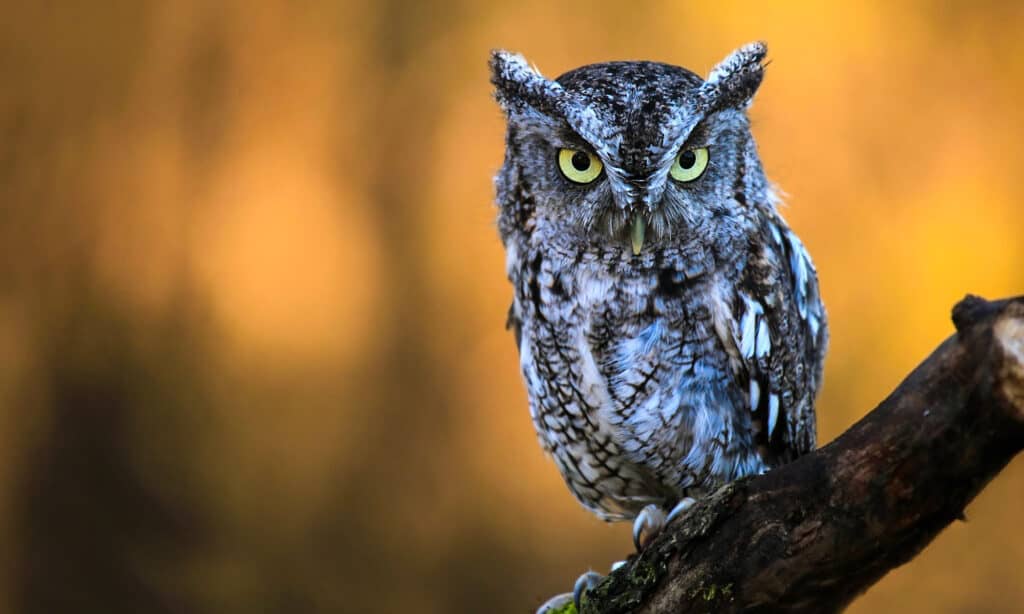
Screech owls have a varied diet and hunt at night.
©mlorenz/Shutterstock.com
Eastern screech owls have two main morphs that can both be found in Michigan. The first is the red morph, which features a red-buffed backside and white chest. The gray morph sports the same markings, but the red coloration is instead gray. This allows it to easily blend into its environments. They are monogamous and will often stay with their mates for life.
The eastern screech owl is a year-round resident of Michigan. They are able to thrive in nearly every habitat so long as they have tree coverage. Although they will be unable to survive in an area if all of the trees are removed, as is the case with development and tree farming, if the trees are replanted, they can return to the area.
8. Snowy Owl
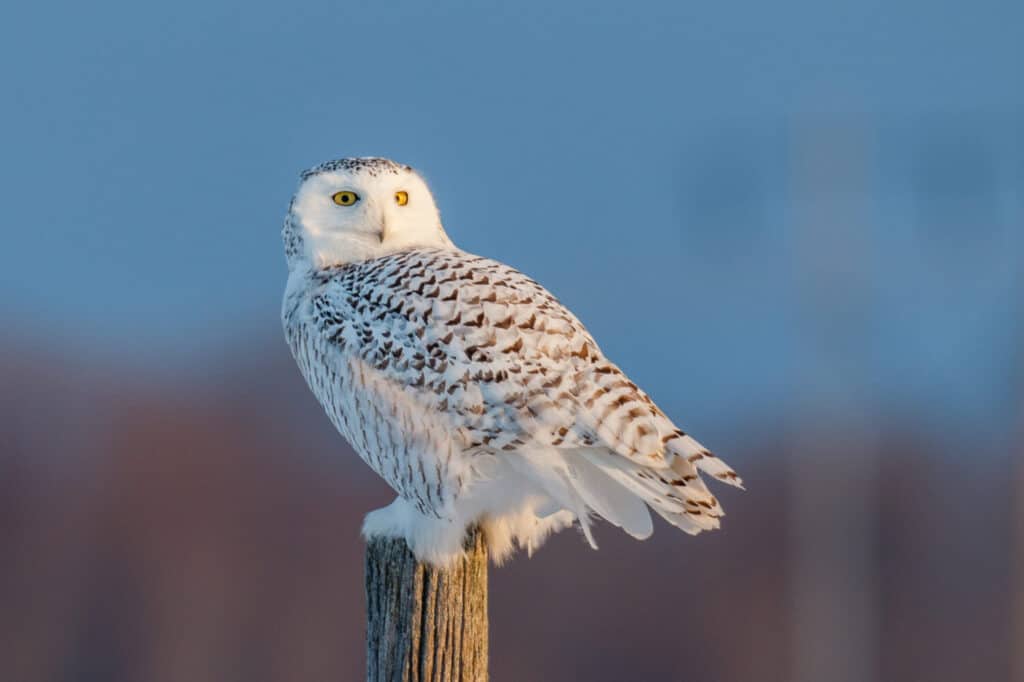
There are an estimated 30,000 snowy owls left in the world.
©Guoqiang Xue/Shutterstock.com
The snowy owl is also known as the polar owl, white owl, and Arctic owl. They only winter in Michigan, preferring to spend summers in the northernmost regions of North America. In contrast to the eastern screech owl, the snowy owl prefers rolling landscapes with no trees. They spend much of their time perched, surveying their surrounding environments.
These owls sport a striking appearance. Males are completely white, while females and juveniles may sport brown markings along their backside and chests. They have sharp yellow eyes. As one of the most agile types of owls in Michigan, they are often able to capture prey while flying. Their prey includes small mammals and other birds.
9. Great Gray Owl

The great gray owl will often use other animals’ nests.
©Lynn_Bystrom/iStock via Getty Images
Great gray owls are one of the rarest types of owls in Michigan. This is because there is no guarantee that they will appear in the state each year. Great gray owls are a resident species in Canada. Occasionally, however, they will migrate south to winter in the northernmost regions of Michigan. You are most likely to find them in forests.
The great gray owl will often reuse its nest site for years to come. Prior to having a nest site, though, it can take them several days up to two weeks to pick the perfect location among several potential spots. They will not build their own nests, however, instead reusing those of other raptors or squirrels in their chosen area.
10. Northern Hawk Owl
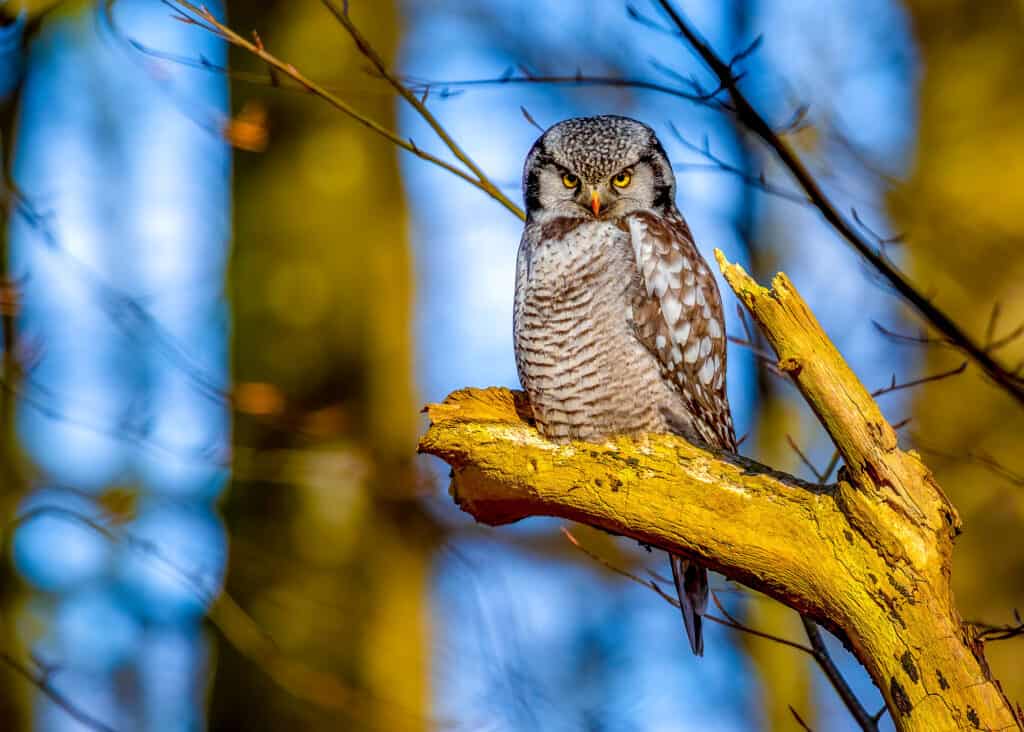
Northern hawk owls can be best identified by the dark border surrounding their faces.
©Svitlana Tkach/Shutterstock.com
The northern hawk owl is another rare species of owl in Michigan. In fact, they are so rare that there is no significant population, resident or migratory, listed in the state. Instead, Michigan sits within the border of potential wintering grounds. Typically, they will only be found this far south when food becomes scarce.
They are named for their behavior. Although they are owls, northern hawk owls behave in a way similar to that of hawks. These owls have long tails, and they are known to hunt prey during the day. On the chance they decide to spend a winter in Michigan, you can identify them by the striking black border framing their white face.
The photo featured at the top of this post is © RStokesPhoto/iStock via Getty Images
Thank you for reading! Have some feedback for us? Contact the AZ Animals editorial team.






